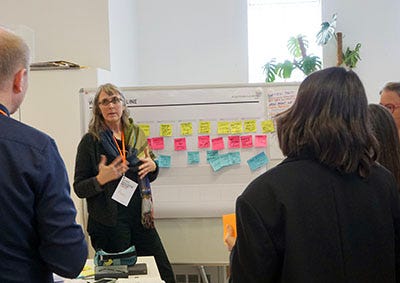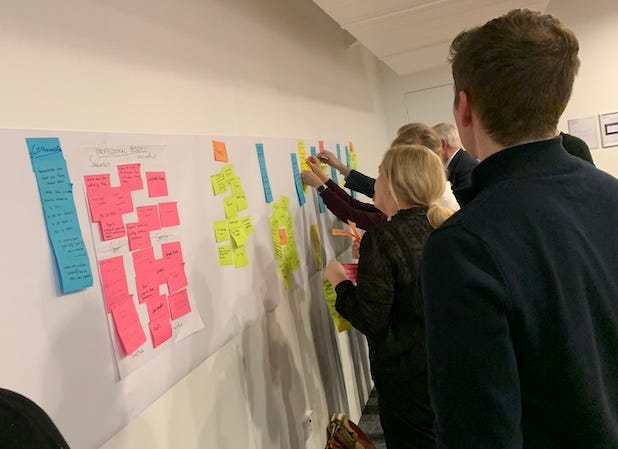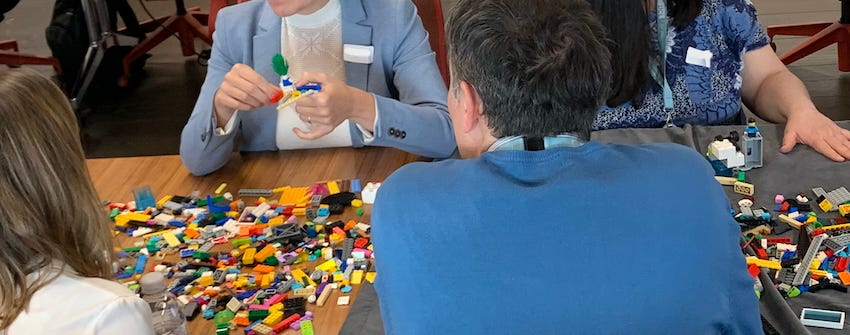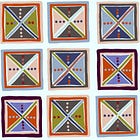Crafting breakthrough moments: my recent cases
In this post I’m sharing overviews of my recent facilitation engagements (anonymized) to show some different “use cases”:
Industry-specific strategic gap analysis
Organisational development (Lego Serious Play)
Cross-functional innovation sandpit (idea lab) leading to funded proposals
The first two describe short, half-day sessions. The last is longer, showing how a carefully structured full-day facilitation can transform strangers into innovation teams with actionable proposals.
Strategic industry workshop for actionable insights
In this case I led a facilitation team for a high-level session of 50+ industry representatives to address critical performance challenges. I used a layered approach with eight “table facilitators.”
The event kicked off with context-setting remarks from three industry insiders (5-10 minutes each). Then I used a visual thinking warm-up to trigger creative energy. Next, I led the room through the architecture of the session, including:
Structured ideation on how the industry deals with challenges now
Table-specific identification of themes and patterns followed by integration of themes across tables
Mixing of groups at the half-way point for cross pollination
Step-by-step prompts for tables to consider gaps, or targeted areas for improvement, in industry performance themes identified
Results
Breakthrough: cross-industry confirmation of key gaps
Surfacing of best practices for broader implementation
Commitment to take the next step in developing cross-industry solutions
Participants’ appreciation of strategic networking opportunities and meeting new colleagues established convening authority for the organizer
Organizational development: navigating change through models
For administrative team leaders who support a department of 600 staff across 9 sites, I designed a targeted Lego Serious Play session on uncertainty around an upcoming department restructuring. Through Lego Serious Play activity, including classic brick warm-ups, eleven participants explored:
What currently motivates them about their work
Their worst fears about the restructure
Their dream scenarios for the restructure.
Results
Breakthrough: Iterations with model-building revealed a broad, highly reassuring alignment in participants’ hopes and fears for the restructure
The session energized participants with experiential activity after a presentation-heavy morning
The team got a new facilitation tool to help them tackle challenges
The session catalyzed energy for designing their “dream scenario”
Cross-functional innovation sandpit (idea lab): from strangers to innovation teams
I designed a carefully iterated 5-hour innovation process that transformed 20 cross-departmental strangers into funded project teams (in the context of a large organization of 16,000 staff).
Ideas market
After a warm-up, the workshop started with an ideas market. I’d cultivated some ideas from participants in advance and loosely categorised these along one wall. Participants reviewed and refined these, then worked with others to cluster the ideas and find a topic that 4 or 5 people were interested in developing further.
Iterations
Groups then took their topics through several iterations of idea development. First each participant presented their “ideal project” in terms of three specific variables (such as “question to answer” and “ways to test the answer”). On large paper the team created a table where each row was one person’s ideal project and the columns were the specific variables. From here the team explored the ideas and synthesized them into one new row which they shared with the room.
In the next round participants again shared their individual view of how the newly synthesized project would work across several specific variables. Then groups worked to refine the synthesized project idea. At this point a few people switched groups for a better fit.
From here, participants used a structured proposal tool (which I developed with colleagues) to create a more detailed outline of the project. Finally, for presenting the proposal to the room, I provided a template “project statement” that helped them boil the project down to its essential ideas. This last step made the final report-back short and accessible.
Facilitator’s notes
A few short presentations (~5 minutes) from key directors were interspersed throughout the morning’s work. This avoided a long “talking heads” kick-off and provided breaks between working cycles. I also gave participants background on the common challenges of cross-functional working and how to overcome them, so they anticipated possible confusion, contradictions, and surprises as a natural part of the process.
Results
Breakthrough: Four groups developed proposals that later secured in-house seed funding
Participants gained transferable, cross-functional collaboration skills
The hosting department established innovation leadership credibility
Directors who gave short talks witnessed a tangible demonstration of innovation culture
Over to you
Do any of these use cases resonate with your or your organisation’s work? Share your experiences in the comments.











